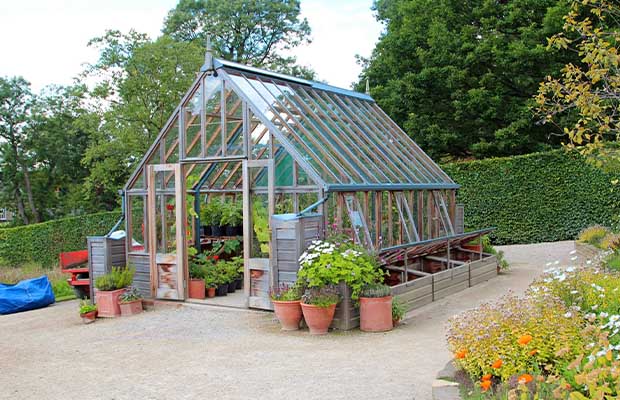Tender plants will be in danger if outside temperatures fall significantly below 0 degrees centigrade, making it impossible to completely protect a cold greenhouse from freezing. In cold climates, a small greenhouse can offer the ideal setting for growing crops that can withstand the winter.
Do you know how to keep a greenhouse warm in the winter? There are some tips you can use such as adding a thermal mass or letting the sunshine in.
After reading this article, you will understand which winter vegetables are suitable for gardening in the colder months as well as how to maintain a warm winter greenhouse.
Table of Contents
What Is A Greenhouse?
Growing plants inside of a controlled environment are made possible by greenhouses, which are enclosures with transparent walls and roofs that let sunlight in. A greenhouse may be made of glass, metal, or a plastic material like polycarbonate sheeting, depending on the type. Sun lamps, heating pads, air circulation, and water misters are just a few of the additions that greenhouses can have to keep their plants healthy. Hobby greenhouses come in a variety of designs, such as a cold frame, an attached greenhouse, and a freestanding greenhouse.
Can Greenhouses Stay Warm In The Winter?
If outside temperatures drop significantly below zero degrees Celsius, tender plants will be at risk and a cold greenhouse cannot be made completely safe from freezing. As a general rule, you can anticipate there to be a 2°C difference between the minimum outdoor temperature and the temperature inside an average cold greenhouse. Each degree of temperature below freezing is crucial for plants, but with the right management, it doesn’t have to be expensive for you or the environment.

Tips To Keep A Greenhouse Warm In The Winter
The plants inside greenhouses are heated by solar energy during the growing season. To keep your greenhouse warm during the winter in cool climates, you’ll need to take a few extra precautions. Take into account these suggestions to warm up your greenhouse for year-round gardening.
- Add a thermal mass. Placing water containers inside the greenhouse is a common technique for producing a thermal mass. Smaller greenhouses can benefit from the placement of covered, one-gallon plastic jugs that have been filled three-quarters full of water among the plants. To increase heat absorption, the water in the jugs can be colored black with food coloring or painted that color.
- Install a heating system. Growers in northern regions, where winter lows drop well below zero, can use a convective electric space heater or if the greenhouse is large, a heating system that can be controlled by a thermostat. To make sure the space heater you select will produce enough heat, determine the greenhouse’s square footage.
- Insulate the interior walls. Products like horticultural fleece and bubble wrap are made specifically to block drafts, insulate greenhouse interior walls, and shield plant roots from cold temperatures while still allowing light to pass through. For transparent insulating materials, check out your neighborhood garden center.
- Use grow lights. Grow lights help keep your growing area warm and can also help add more UV light to promote plant growth during the gloomy winter months.
- Let the sunshine in. The greenhouse should already be in a location that is free of shading from trees or other buildings if the contractor was wise about the site and space planning of the building when it was constructed. However, other obstructions may cast shadows when the sun is lower in the sky, so be sure the greenhouse is receiving as much light as you can.
- Put a germination mat to use. A germination mat can meet your client’s needs if they plan to use their greenhouse primarily in the winter to start their spring plants. By preserving the ideal root-zone temperature and speeding up early growth rates, these mats assist in reducing production time.
- Cover up. When it comes to covering plants during particularly chilly nights to provide additional degrees of warmth, customers can go as elaborate or as simple as they want. Row covers, tarps, horticultural fleece, sheets, and tarps can all be used to keep moisture in the soil. However, clients should be reminded to keep the covers off the plants themselves and to remember to take them off during the day because too much humidity can build up.
- Create some compost. If a customer already has a pile of compost, moving it to the center of the greenhouse can be advantageous because it keeps the compost warmer and more protected from the elements. As a result, the process can proceed more quickly while also increasing the greenhouse’s temperature and decomposing materials. The pile should be placed in the middle of the greenhouse, but if that isn’t possible, it can be put anywhere else and still provide warmth. The homeowner will also have a ready supply of black gold come spring.
Read More:
What Are Vegetables You Can Grow In Unheated Greenhouses?
Winter vegetable gardening in greenhouses allows for the production of a wide range of vegetables.
- Leafy greens: The best leafy greens for winter growing are those that can withstand cold temperatures, like kale, arugula, collards, and chard.
- Root vegetables: Exceptional choices for winter greenhouse growing include root vegetables like turnips, carrots, and beets.
- Brassicas: Veggies belonging to the Brassica family, such as broccoli, During the winter, it is possible to grow cabbage and brussels sprouts in an unheated greenhouse.
- Alliums: Veggies belonging to the Allium family, including leeks, garlic, and scallions, do well in winter gardens.

















